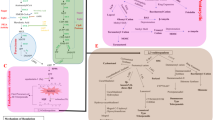Summary
Measurements were made of induction of ornithine decarboxylase activity after painting mouse skin with 12-O-hexadecanoyl-16-hydroxyphorbol-13-acetate and its two epimeric 4-deoxy-analogs, 12-O-hexadecanoyl-4-deoxy-16-hydroxyphorbol-13-acetate and 12-O-hexadecanoyl-4-deoxy-4α-16-hydroxyphorbol-13-acetate. The inductive activities of HHPA and 4-deoxy-HHPA were similar, but 4-deoxy-4α-HHPA had no inductive activity. These findings on natural phorbol esters confirm that both the 4β-hydrogen and the 4β-hydroxyl in phorbol esters are essential for ODC-inducing activity. The interactions of 4-deoxy-HHPA and 4-deoxy-4α-HHPA with a possible receptor are discussed.
Similar content being viewed by others
Abbreviations
- ODC:
-
ornithine decarboxylase
- TPA:
-
12-O-tetradecanoylphorbol-13-acetate
- PDD:
-
phorbol-12,13-didecanoate
- HHPA:
-
12-O-hexandecanoyl-16-hydroxyphorbol-13-acetate
- 4-deoxy-HHPA:
-
12-O-hexadecanoyl-4-deoxy-16-hydroxyphorbol-13-acetate
- 4-deoxy-4α-HHPA:
-
12-O-hexadecanoyl-4-deoxy-4α-16-hydroxyphorbol-13-acetate
References
Diamond L, O'Brien T, Rovera G (1978) Tumor promoters inhibit terminal cell differentiation in culture. In: Slaga TJ, Sivak A, Boutwell RK (eds) Carcinogenesis, vol. 2, Mechanisms of tumor promotion and cocarcinogenesis. Raven Press, New York, pp 335–341
Fürstenberger G, Hecker H (1977) The new diterpene 4-deoxyphorbol and its highly unsaturated irritant diesters. Tetrahedron Lett 11:925–928
Hecker E (1967) Phorbol esters from croton oil, chemical nature, and biological activities. Naturwissenschaften 54:282–284
Hecker E (1971) Isolation and characterization of the cocarcinogenic principles from croton oil. In: Busch H (ed) Methods in cancer research, vol.6. Academic Press, New York London, pp 439–484
Hecker E, Schmidt R (1974) Phorbolesters-the irritants and cocarcinogens of croton tiglium L. Progr Chem Org Natur Prod 31:377–467
Heil A, Zilling W (1970) Reconstitution of bacterial DNA-dependent RNA-polymerase from isolated subunits as a tool for the elucidation of the role of the subunits in transcription. FEBS Lett 11:165–168
Hirota M, Ohigashi H, Koshimizu K (1979) Piscicidal constituents and the related diterpene esters from Aleurites fordii. Agr Biol Chem 43:2523–2529
Jacobi P, Härle E, Schairer, HO, Hecker E (1970) Zur Chemie des Phorbols XVI, 4α-Phorbol. Liebigs Ann Chem 741:13–32
Miana GA, Schmidt R, Hecker E, Shamma M, Moniot JL, Kiamuddin M (1977) 4α-Sapinine-a novel diterpene ester from sapium indicum. Z Naturforsch 32B:727–728
O'Brien TG, Simsiman RC, Boutwell RK (1975) Induction of the polyamine-biosynthetic enzymes in mouse epidermis by tumor-promoting agents. Cancer Res 35:1662–1670
Okuda T, Yoshida T, Koike S, Toh N (1975) New diterpene esters from aleurites fordii fraits. Phytochemistry 14:509–515
Raineri R, Simsiman RC, Boutwell RK (1973) Stimulation of the phosphorylation of mouse epidermal histones by tumor-promoting agents. Cancer Res 33:134–139
Russel D, Snyder SH (1968) Amine synthesis in rapidly growing tissues: ornithine decarboxylase activity in regenerating rat liver, chick embryo, and various tumors. Proc Natl Acad Sci USA 60:1420–1427
Van Duuren BT (1969) Tumor-promoting agents in two-stage carcinogenesis. Prog Exp Tumor Res 11:31–68
Weber J, Hecker E (1978) Cocarcinogens of the diterpene ester type from croton flavens L. and esophageal cancer in Curacao. Experientia (Basel) 34:679–682
Weinstein IB, Wigler M, Fisher PB, Sisskin E, Pietropaolo C (1978) Cell culture studies on the biologic effects of tumor promoters. In: Slaga TJ, Sivak A, Boutwell RK (eds) Carcinogenesis, vol. 2, Mechanisms of tumor promotion and cocarcinogenesis. Raven Press, New York, pp 313–333
Author information
Authors and Affiliations
Additional information
This work was supported by Grants-in-Aid for Cancer Research from the Ministry of Health and Welfare and the Ministry of Education, Science, and Culture of Japan
Rights and permissions
About this article
Cite this article
Fujiki, H., Mori, M., Sugimura, T. et al. Relationship between ornithine decarboxylase-inducing activity and configuration at C-4 in phorbol ester derivatives. J Cancer Res Clin Oncol 98, 9–13 (1980). https://doi.org/10.1007/BF00413172
Received:
Accepted:
Issue Date:
DOI: https://doi.org/10.1007/BF00413172




